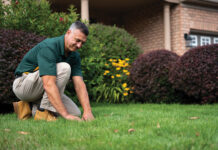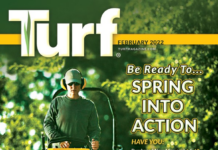Most of the New England region and the Midwest has experienced snow cover for at least 60 days (even longer for the northern areas), and these conditions create a high likelihood of snow mold damage on turf.
The deep snow cover provides very stable temperatures (just below freezing) that are ideal for snow mold fungi to infect turfgrass.
Areas that have not been treated with a fungicide may have some level of snow mold damage. While this damage can be unsightly in early spring, turfgrass will recover. Here are a few measures to enhance recovery:
- As the snow starts to melt, create drainage channels to
reduce/divert standing water in low-lying areas. - Once affected areas have dried, lightly rake damaged areas to
increase air circulation and remove damaged foliage. - Light to moderate nitrogen application will also help recovery.
- Severely damaged areas may require reseeding.

You can learn more about cold-loving turfgrass pathogens, such as Typhula blight and Microdochium patch (along with nice images of each), and their treatment options by visiting extension.umass.edu/turf/management-updates/snow-molds-3 for the latest UMass TurfTalk update.











![[VIDEO] Dickies®: Discover Workwear That’s Anything But Uniform](https://turfmagazine.com/wp-content/uploads/2023/06/1647663814-4b1a2a7742790a9b1e97a3b963477850192e1d6a9dfba9b07214a77bae25d6e3-d-218x150.jpg)





























![[VIDEO] Dickies®: Discover Workwear That’s Anything But Uniform](https://turfmagazine.com/wp-content/uploads/2023/06/1647663814-4b1a2a7742790a9b1e97a3b963477850192e1d6a9dfba9b07214a77bae25d6e3-d-324x160.jpg)